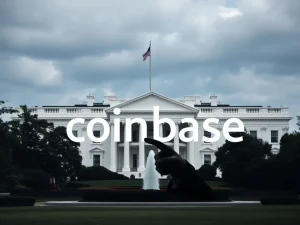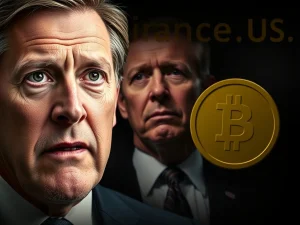Unveiling Resilience: US Banks Sustain Record Credit Card Approvals Amidst Economic Shifts

Even as the crypto market navigates its own unique currents, the traditional finance sector, particularly U.S. banks, is showcasing a fascinating display of resilience. Despite whispers of contraction and economic volatility, major financial institutions are not only maintaining but, in some cases, setting new records for credit card approvals. This unexpected surge, even amidst a reported 5% drop in Q2, highlights a strategic recalibration rather than a retreat. What’s truly happening behind the scenes, and how are banks balancing consumer demand with rising risks?
The Enduring Strength of Credit Card Approvals
Contrary to some narratives suggesting a tightening of consumer credit, U.S. banks have demonstrated remarkable fortitude in sustaining robust credit card approvals into 2025. Leading institutions like JPMorgan Chase and American Express have reported record-high application volumes, a testament to continued consumer demand for credit. Jamie Dimon, CEO of JPMorgan Chase, aptly noted, “we are witnessing record-high application volumes and a robust demand for credit cards as we enter 2025.”
- Record Application Volumes: Major banks are seeing unprecedented numbers of credit card applications.
- Defying Contraction Narratives: Despite reports of a 5% decline in Q2, the overall trend remains strong.
- Sector Resilience: This sustained activity underscores the financial sector’s ability to adapt to economic shifts.
Historically, periods of economic uncertainty, such as the 2008 financial crisis or the 2020 pandemic onset, led to significant tightening of credit policies. However, current data indicates a different approach, with no immediate widespread defensive measures observed in new card issuance. This nuanced situation demands a closer look at the underlying strategies.
How Are Lending Standards Adapting to New Realities?
The apparent contradiction between record approvals and a reported Q2 decline points to a sophisticated adjustment in lending standards. Rather than a blanket restriction, banks are implementing targeted recalibrations to mitigate risks, especially concerning lower-income applicants. This strategic pivot allows them to maintain high approval volumes while exercising prudence.
William Dudley, former Federal Reserve Bank of New York president, observed, “While credit card delinquency rates are rising, we do not see a corresponding drop in approvals which remains strong across major issuers.” This suggests that banks are not simply cutting off access but are refining their criteria. For example, U.S. Bank has modified terms for existing Smartly credit card accounts, balancing consumer demand with a cautious approach.
The reduced enforcement capacity of the Consumer Financial Protection Bureau (CFPB) has also granted banks greater flexibility in setting terms, further influencing these dynamic lending strategies. This newfound agility allows financial institutions to respond more swiftly to market conditions and internal risk assessments.
What Challenges Do US Banks Face Amidst Rising Delinquencies?
While US banks are maintaining high approval rates, they are not immune to rising delinquency rates. Interestingly, these increases are observed even in high-income ZIP codes, signaling a broader economic strain. Experts caution that if these defaults continue their upward trajectory, a more significant tightening of credit policies could become inevitable.
The interplay between macroeconomic factors and institutional risk management is becoming increasingly evident. Prolonged inflation and shifting consumer behavior, exacerbated by dwindling pandemic-era savings, are key considerations for banks. Consumers are grappling with higher costs of living, which directly impacts their ability to service debt.
The Crucial Role of Risk Mitigation in Modern Lending
In this evolving landscape, banks are prioritizing risk mitigation over aggressive market share expansion. This strategic pivot is a clear signal of their cautious stance amidst economic uncertainty and political rhetoric. Despite stock indices reaching record highs, lending institutions are adopting prudent measures, including:
- Modifying Existing Account Terms: Adjusting interest rates, credit limits, or rewards programs for current cardholders.
- Scrutinizing High-Risk Applications: Implementing more stringent checks for applicants deemed to have a higher default probability.
- Strategic Portfolio Management: Diversifying credit offerings and adjusting exposure to different consumer segments.
This approach allows banks to navigate the complexities of consumer finance without entirely curtailing credit availability. Maintaining access to credit for both consumers and businesses is vital for sustaining economic momentum, especially as corporations grapple with tariff-driven cost pressures and regulatory ambiguities.
Understanding Consumer Credit Dynamics in a Shifting Market
The broader landscape of consumer credit is also being shaped by alternatives like the Buy Now, Pay Later (BNPL) sector. The growth of BNPL reflects a shift in consumer preferences, offering installment-based payment options that sometimes bypass traditional credit checks. However, banks remain central gatekeepers, primarily by adjusting approval thresholds rather than restricting access entirely.
Federal Reserve data indicates that these trends in traditional credit markets have not had direct impacts on the crypto market, suggesting the nascent sector’s stability is not yet compromised by fluctuations in conventional lending. This separation highlights the distinct dynamics at play in different financial ecosystems.
The divergent data points—rising approvals versus reported Q2 contractions—underscore the complexity of interpreting lending trends. Verified data remains paramount in shaping market perceptions, as credit volatility influences both traditional and decentralized finance sectors. As institutions continue to monitor delinquency rates and broader economic conditions, the delicate balance between credit accessibility and robust risk management will undoubtedly define the next phase of credit card issuance.
Conclusion: A Balancing Act for Financial Stability
The story of U.S. banks and credit card approvals in 2025 is one of sophisticated adaptation. Far from simply tightening the reins, major financial institutions are strategically recalibrating their lending standards, prioritizing risk mitigation while striving to meet robust consumer demand. This nuanced approach, driven by economic realities and regulatory shifts, highlights a commitment to stability in a dynamic financial landscape. The ability of banks to navigate rising delinquencies and economic uncertainties while maintaining credit flow will be crucial for the overall health of the economy, serving as a fascinating case study in financial resilience.
Frequently Asked Questions (FAQs)
Q1: Why are U.S. banks sustaining high credit card approvals despite economic concerns?
U.S. banks are maintaining high credit card approvals due to robust consumer demand and a strategic shift towards adjusting lending standards rather than outright restricting access. They are implementing targeted risk mitigation measures, allowing them to balance growth with prudence.
Q2: What does the reported 5% Q2 drop in approvals signify?
The reported 5% Q2 drop is likely part of a broader strategic recalibration by banks. It signifies a more selective approach, particularly towards lower-income applicants or those with higher risk profiles, rather than a general contraction in the market.
Q3: How are rising delinquency rates affecting banks’ lending strategies?
While rising delinquency rates, even in high-income areas, are a concern, they have not yet led to a widespread drop in approvals. Banks are closely monitoring these rates and are adjusting terms and scrutinizing high-risk applications to manage potential defaults without entirely curtailing credit.
Q4: What role does the Consumer Financial Protection Bureau (CFPB) play in current lending trends?
The article suggests that reduced enforcement capacity of the CFPB has granted banks greater flexibility in setting credit terms. This increased autonomy allows banks more agility in responding to market conditions and implementing their risk management strategies.
Q5: Is there any direct impact of these credit card trends on the cryptocurrency market?
According to Federal Reserve data cited in the article, there is currently no direct impact of these traditional credit card trends on the cryptocurrency market. This suggests that the crypto sector’s stability is not yet compromised by fluctuations in conventional lending.
Q6: What is the long-term outlook for consumer credit availability?
The long-term outlook for consumer credit availability will depend on the balance banks strike between accessibility and risk management. As economic conditions evolve and delinquency rates are monitored, banks will continue to adjust their strategies, likely favoring a cautious but accessible approach to maintain economic momentum.








